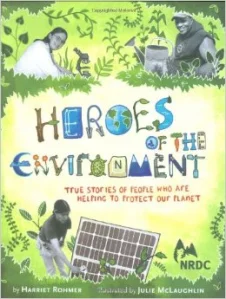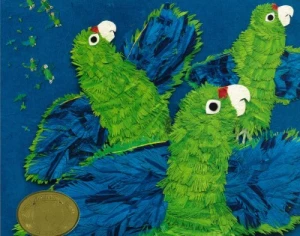by Lila Quintero Weaver
 Facts to contemplate and amaze: 1. A high percentage of Latin@s are persuaded that a connection exists between global warming and human activity. 2. A majority of Latin@s feel global warming carries an extreme or very serious potential to affect their lives.
Facts to contemplate and amaze: 1. A high percentage of Latin@s are persuaded that a connection exists between global warming and human activity. 2. A majority of Latin@s feel global warming carries an extreme or very serious potential to affect their lives.
According to the findings of a new poll conducted by The New York Times, in conjunction with Stanford University and Resources for the Future, an environmental research group, “Hispanics are more likely than non-Hispanic whites to view global warming as a problem that affects them personally. It also found that they are more likely to support policies, such as taxes and regulations on greenhouse gas pollution, aimed at curbing it.”
 The article in the New York Times acknowledges that these findings challenge stereotypes about Latin@s, as well as common assumptions that saving the environment is of concern mostly to white liberals.
The article in the New York Times acknowledges that these findings challenge stereotypes about Latin@s, as well as common assumptions that saving the environment is of concern mostly to white liberals.
So where are the books for kids that highlight this vigorous interest among Latin@s in saving the environment? My answer: they’re not easy to find and it sometimes means digging within tables of contents to discover a chapter or two featuring Latin@s.
Here are a handful of kids’ books sure to inspire a new generation of Latin@ planet saviors. Consider adding them to your Earth Day observations (April 22).
HEROES OF THE ENVIRONMENT: TRUE STORIES OF PEOPLE WHO ARE HELPING TO PROTECT OUR PLANET, by Harriet  Rohmer
Rohmer
This nonfiction book for grades 4 and up celebrates the environmental triumphs achieved by a dozen unsung heroes of all ages located in various parts of the United States and Mexico. I’m giving it star billing because I feel it deserves wider attention. The environmental challenges the activists take on—from urban gardens to saving caribou—are as diverse as the heroes themselves. Of the twelve, three heroes are Latin@, two are Native American, two are African American, one is Asian American and the remaining four are white. Rohmer relates the story of each person’s activism in a short chapter illustrated with photos and art by Julie McLaughlin.
The determination, innovation and enterprising spirit shown by all twelve heroes is truly inspiring. Here is a brief recounting of one of their stories. Erica Fernandez is a young immigrant from Mexico who learns of plans by an Australian company to build a large processing station for liquefied natural gas near her new hometown in California. If the company’s plans go through, a large, potentially lethal gas line would run directly beneath her community. Using Spanish and broken English, Erica sets out to inform neighbors and elected officials about the grave risks. The outcry of the community eventually reaches the ears of the governor, who nixes plans for the gas line.
In addition to the stories already alluded to, you will also find:
- A Hopi girl installing solar panels on her reservation
- A teacher turning the protection of wetlands into a classroom project
- A man designing a unique bio-digestive sewage-treatment system
- A boy organizing the safe disposal of old electronics
- A lucha libre warrior fighting to protect coastlines and waterways
- A woman taking on the coal company responsible for destructive mountaintop removal in her West Virginia location
- A Bronx resident turning the problem of construction-site trash into a cooperative business
- A young woman inventing a device for purifying polluted water
- A Louisiana woman pressuring an oil company to relocate an entire community victimized by toxic disposal
The quieter message of this book is thrilling to me: that anyone can make a difference to the health of our planet—people of all ages, ethnic backgrounds and economic or educational levels.
 PARROTS OVER PUERTO RICO, by Susan L. Roth and Cindy Trumbore
PARROTS OVER PUERTO RICO, by Susan L. Roth and Cindy Trumbore
This ingeniously illustrated picture book about a parrot species brought to the brink of extinction and the valiant efforts underway to rescue it, has received well-deserved acclaim. The story of Puerto Rico’s iguaca parrots demonstrates the vulnerability of all biological species, especially to the encroachment of human activity. Over the course of centuries, natural enemies preyed on the iguaca’s nests and hurricanes damaged their forest habitats, but it was humans who posed the biggest threat, primarily by trapping the birds and destroying their nesting sites. In 1968, when the iguaca population stood at less than thirty, Puerto Ricans jumped into action to save the birds. Thanks to their efforts, iguaca parrots’ numbers are on the rise again. An afterword provides further details on the Parrot Recovery Program.
SAVING BIRDS: HEROES AROUND THE WORLD, by Peter Salmansohn and Peter W. Kress
This book teaches young readers about preservation efforts on behalf of endangered birds in six locations around the world. One chapter focuses on a Latin American bird of legend, the quetzal. Like many animals of exceptional beauty, the quetzal has been exploited and poached. Furthermore, its habitat in Central America’s cloud forests is under threat by human activity, including deforestation and fires. Two men employed by a natural reserve in Chiapas, Mexico, called El Triunfo, set out to address the educational gaps surrounding the quetzal. Using puppet shows and books, they have recruited the support of children in villages throughout the region, teaching them to prize the quetzal and its forest home.
LUZ MAKES A SPLASH, by Claudia Dávila
 How can young readers learn about something as abstract as water conservation? This graphic novel for elementary grades introduces wise water-usage in a kid-friendly package. It’s part of a two-book series called The Future According to Luz. The companion book is entitled Luz Sees the Light. Luz Makes a Splash is built around an eponymous character and a community of friends and family whose lives are affected in multiple ways by scorching temperatures and drought conditions. Gardens are drying up. So is a city park and Luz’s favorite spring-fed pond. It turns out that a nearby soft-drink company is tapping groundwater to manufacture its cola products, and this contributes to the pond’s receding water level. A group of citizens mobilizes to address the problem. Meanwhile, Luz learns about rain barrels and a natural system for filtering household water used for cooking and washing (gray water). One of the story’s characters converts his sod lawn into a rock garden built around indigenous plants capable of thriving in drought conditions.
How can young readers learn about something as abstract as water conservation? This graphic novel for elementary grades introduces wise water-usage in a kid-friendly package. It’s part of a two-book series called The Future According to Luz. The companion book is entitled Luz Sees the Light. Luz Makes a Splash is built around an eponymous character and a community of friends and family whose lives are affected in multiple ways by scorching temperatures and drought conditions. Gardens are drying up. So is a city park and Luz’s favorite spring-fed pond. It turns out that a nearby soft-drink company is tapping groundwater to manufacture its cola products, and this contributes to the pond’s receding water level. A group of citizens mobilizes to address the problem. Meanwhile, Luz learns about rain barrels and a natural system for filtering household water used for cooking and washing (gray water). One of the story’s characters converts his sod lawn into a rock garden built around indigenous plants capable of thriving in drought conditions.
The author-illustrator of Luz Makes a Splash is Chilean-Canadian. She has made her energetic, intelligent and community-minded main character a Latina. Ethnic identity doesn’t figure into the story, but what a nice way to counteract stereotypes of Latin@s.
This is a book with a message. Some readers will find fault with its didactic approach and the fact that the characters are not given a broader story, but taken as a teaching tool, it delivers solid information that can be used to launch explorations into drought, government-enforced water restrictions, and smart solutions for reducing water waste and keeping gardens green during low-water conditions.
*****
The focus of this post is Latin@ activism for earth-friendly causes, but a growing number of works on the Latin@ kid lit bookshelf celebrate the planet.
 Margarita Engle can be counted on to inject nature, naturalists, biodiversity, and environmental conservation in nearly all her books and has received recognition for her stand on these issues. Recently, Green Earth Book Awards shortlisted Silver People for its 2015 honors. Congratulations, Margarita!
Margarita Engle can be counted on to inject nature, naturalists, biodiversity, and environmental conservation in nearly all her books and has received recognition for her stand on these issues. Recently, Green Earth Book Awards shortlisted Silver People for its 2015 honors. Congratulations, Margarita!
Two of Margarita’s 2015 releases embrace the wonders of nature.
For more Earth Day-friendly books with Latin@ connections, check out these additional selections:
Need classroom resources related to the field of environmental activism?
Click here for information on The Américas Latino Eco Festival. Don’t overlook Mujeres de la Tierra, an inspiring group of activists located in California.
Read about the amazing Xiuhtezcatl Martínez, a 14-year old champion of the planet!
For additional insights on the environmental heroes and projects featured in this post, check out these resources:
Omar Freilla is a New Yorker who appears in Heroes of the Environment. Here’s an article about his work.
Erica Fernanadez is another of the true-life characters in Heroes of the Environment. Here’s a video about her campaign for a cleaner environment:
As a follow up on Saving Birds, don’t miss this spectacular video of quetzals caring for their young.
And for young children, don’t forget Dora the Explorer’s cousin Diego, a passionate advocate for the environment!







Thank you so much for including my books! As a botanist and agronomist, these topics are really important to me. I have been writing a series of picture books about great Latino naturalists who have been forgotten by history, but it’s difficult to find publishers for biographies of people who aren’t considered “famous enough.” This is one of the essential factors currently limiting diversity in children’s literature.
Margarita, we are great fans of yours at Latin@s in Kid Lit! Thank you for leading the way with books that elevate the beauty of our planet.
Reblogged this on The Eclectic Kitabu Project.
Pingback: Heroes of the Environment - Social Justice Books
Pingback: Luz Makes a Splash - Social Justice Books
Pingback: Celebrate Earth Day By Reading Kid Lit Books As An Ecocritic | Latinxs in Kid Lit
Pingback: Book Review: Margarito’s Forest/El bosque de don Margarito | Latinxs in Kid Lit